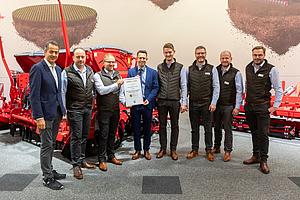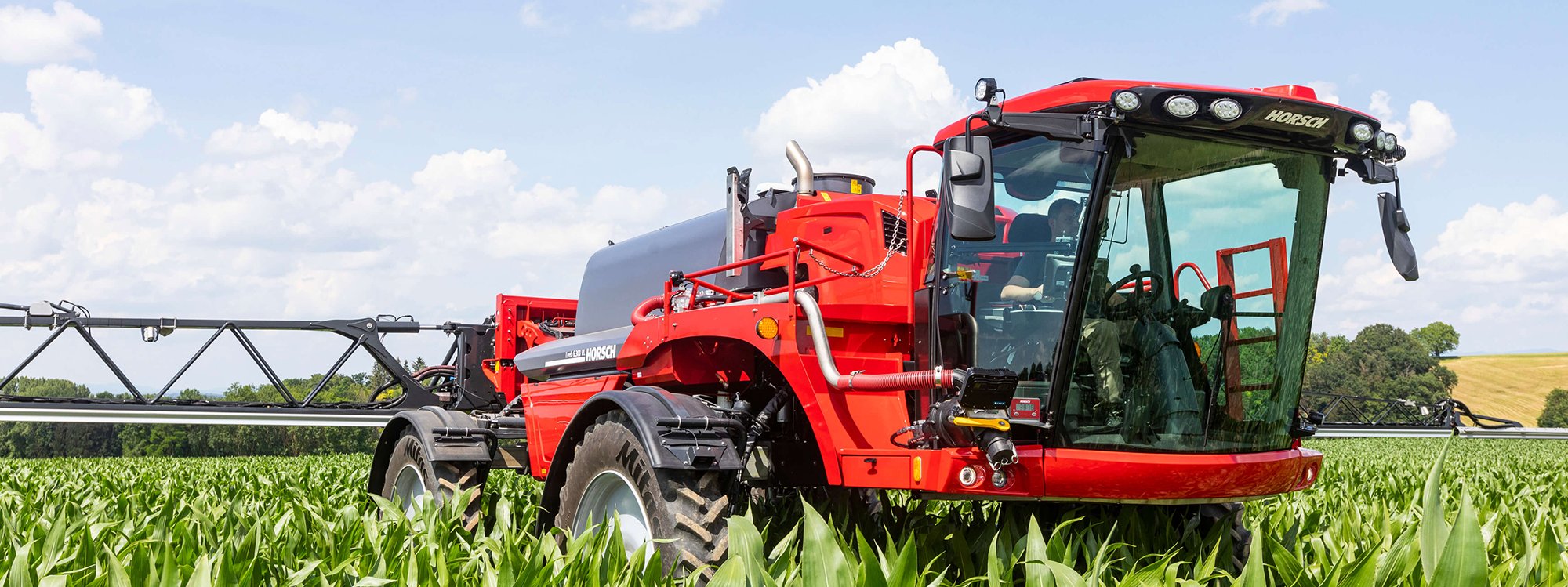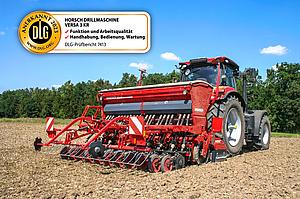DLG APPROVED 2023: Test report for the mechanical seed drill Versa 3 KR
The mechanical seed drill Versa 3 KR was awarded the quality mark DLG APPROVED 2023 in the DLG test report 7413. It impressed due to very good results for the DLG test criteria “Functionality and quality of work” as well as “Handling, operation and maintenance”. The award was presented at the Agritechnica 2023.

Summary of the DLG test report
Test criterion | Result |
Lab test metering accuracy | Very good and good |
Lab test lateral distribution | Very good |
Field test metering accuracy | Very good |
Field test emergence | Very good |
Field test distribution along the rows | Very good and good |
Handling, operation and maintenance | Very good and good |
Table 1
Overview of the DLG evaluation of the HORSCH Versa 3 KR
DLG test module „Functionality and quality of work”
The mechanical seed drill was tested with regard to parameters such as “metering accuracy” and “lateral seed distribution” in order to evaluate the functionality and quality of work.
Lab test of the Versa 3 KR
During the lab tests, the metering accuracy and the lateral seed distribution of rapeseed, barley and wheat were examined. Two different operational speeds were tested with the stationary seed drill in level position. The drilling of wheat was additionally tested on a simulated slope.
Metering accuracy results
It was evaluated whether the seed rate of the drill (actual quantity) is identical to the pre-set rate (target quantity).
The Versa 3 KR showed very good results in the lab test of the metering accuracy of rapeseed, barley and wheat on level ground. The results for wheat on the simulated slope were very good and good. The filling level of the seed hopper and the operational speed did not influence the results.
Lateral seed distribution results
The lateral distribution of rapeseed, barley and wheat was evaluated with a stationary and lifted seed drill. The seed drill was tested on level ground. Drilling on slopes was simulated with wheat.
The accuracy of the lateral distribution achieved very good results for each seed type and in all test conditions.
Field test of the Versa 3 KR
The surrounding conditions of the field tests were examined and recorded before, during and after seeding. This includes e.g. the condition of the seedbed, previous crop, prior tillage, seeding conditions, seed and precipitation amount between seeding and rating.
Results of the metering accuracy while seeding
The metering accuracy was checked in each field directly while seeding.
| Metering accuracy of winter rapeseed | Very good |
| Metering accuracy of winter wheat | Very good |
Emergence results
The plants were counted and evaluated in representative plots 3 to 4 weeks after seeding.
| Emergence winter rapeseed | Very good |
| Emergence winter wheat | Very good |
Results of the plant distribution along the rows (longitudinal distribution)
A measuring tape was placed along a representative seed row 3 - 4 weeks after seeding. The plants that emerged within a set interval were counted.
| Longitudinal distribution of winter rapeseed (length 30 m, interval 15 cm) | Very good |
| Longitudinal distribution of winter wheat plants (length 15 m, interval 5 cm) | Good |
Result of the depth placement of the seed (wheat)
The depth placement of wheat was checked at two different seed depths (2cm and 4cm). This was done by uncovering 100 plants in one row and measuring the section between the root and the surface of the soil 3 to 4 weeks after seeding.
The examination if both set seed depth were kept up showed a standard deviation of only 0,4 cm. This result indicates a very good and consistent depth placement of the seed by the Versa 3 KR.
DLG test module „Handling, operation and maintenance“
A number of setting options for the seed drill were assessed using DLG evaluation schematics. Expert operators carried out pre-set service and maintenance steps. Each step was timed.
Handling
The lighting system and the setting of the coulter pressure were rated “very good”. Positively highlighted were the fixed installation of the lighting system as well as the uncomplicated adjustment of the coulter pressure by operating the hydraulic control device while driving.
The setting of the placement depth, the calibration test and the storage option for the hydraulic lines achieved good results. The user-friendliness of the adjustment of the placement depth and the steps of the calibration test were especially mentioned. The clear arrangement of the hydraulic lines was also highlighted in the DLG test report.
Operation and maintenance
During the examination of the operating and maintenance steps, the average duration and required tools for the following tasks were determined and recorded:
- Grease all grease nipples incl. PTO shaft
- Change from transport to work position
- Change from fine seeds to cereals
- Set the desired seed rate
- Remove 5 kg of residual seeds from the seed hopper



DLG with test expertise in agricultural technology
With its methods, test frameworks and awards, the DLG Test Center Machinery & Farm Inputs is a leader in the field of testing and certification of agricultural technology and inputs. The methods and test profiles are practice-oriented, independent, and developed by unbiased examination committees. They are based on state-of-the-art testing methods. International standards and norms are also taken into account.
The quality mark „DLG APPROVED specific criteria” is awarded to technical products that have successfully passed a less comprehensive DLG usability test according to independent and recognized evaluation criteria. The purpose of the examination is to highlight special innovations and key criteria of the tested machine.
The „Approval in specific criteria” highlights special innovations and key features of the product. The DLG quality mark is valid for five years from the date of the award.





